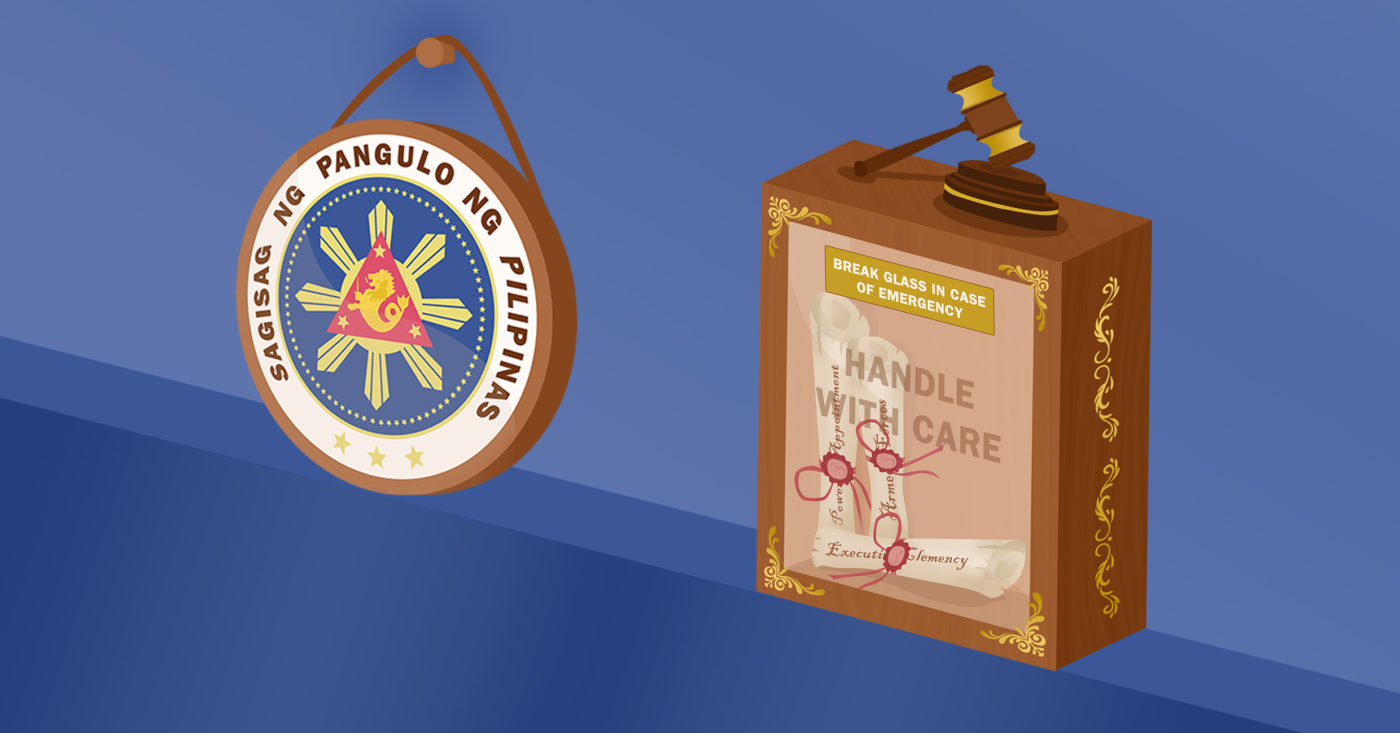ON OCTOBER 25, 2007, incumbent President Gloria Macapagal-Arroyo infamously granted her ousted predecessor Joseph Estrada executive clemency, pardoning him of his plunder verdict and penalty of life imprisonment. 13 years later, another grant of executive clemency garnered controversy after President Rodrigo Duterte pardoned United States Marine Joseph Scott Pemberton, who murdered transgender woman Jennifer Laude.
Executive clemency is a powerful presidential power that should not be underestimated, as are other powers afforded to the president. The ability to circumvent the entire judicial process via executive clemencies—or enforce constitutional and statutory powers via executive orders—is remarkable as it is formidable.
This explainer hopes to impart an understanding of these powers by explaining their quirks, limits, and use over the years.
At the ready
The presidential office is armed with an array of powers, endowing the president with the means to enforce the will of the Constitution and their administration as they see fit. Briefly enumerated below are some of the more notable presidential powers.
The first notable presidential power is the pardoning power or executive clemency. This is a unique fail-safe that enables the president to grant certain individuals relief from the harsher repercussions of the law, or to correct mistakes in administered justice. There are five varieties of this power: Reprieves, commutations, remit fines and forfeitures, amnesties, and absolute and conditional pardons.
The pardon controversially bestowed to former President Estrada and murderer Pemberton were absolute pardons, effectively absolving the penalties accrued from their crimes. Inversely, the presidential Christmas tradition of pardoning inmates often comes in the form of conditional pardons with rules that should not be broken, or commutations that relegate penalties to less lengthy and severe forms.
Meanwhile, the executive power is arguably the most direct and visible of all the president’s powers. It describes the powers exercised by the president as the head of the executive branch—controlling the executive departments as well as reconfiguring and appointing its respective officials.
A notable example of this was when incumbent President Manuel Roxas established the Department of Foreign Affairs in 1946. Roxas also exercised the power to restructure the government the following year by establishing the Philippine Constabulary and abolishing the Bureau of Aeronautics, among others.
Ordinance power, on the other hand, is the more familiar and publicized presidential power that allows the president to further smoothen and simplify the administration’s activities via executive issuances. These issuances may take the form of executive orders, administrative orders, proclamations, memorandum orders and circulars, and general or special orders.
Examples of this power are rather abundant. In 2006, following claims of a possible coup, incumbent President Gloria Macapagal-Arroyo placed the country in a state of national emergency through Proclamation No. 1017. The issuance was followed by General Orders No. 5, No. 6, and Administrative Order No. 143, mobilizing the Armed Forces of the Philippines and the Philippine National Police to keep the peace and quell treasonous forces.
Lastly, military power—perhaps the most infamous due to their penchant to be misused—are the powers vested to the president per their capacity as the country’s Commander-in-Chief. It allows the president to mobilize military and police forces when needed, suspend the writ of habeas corpus, as well as enforce martial law come extreme cases of invasion, rebellion, or public safety intervention.
A dark example etched grudgingly within the country’s history is incumbent President-turned-dictator Ferdinand Marcos’ declaration of Martial Law in 1972, paving the way for 14 years of authoritarian rule. Duterte, following the wake of the 2017 Marawi siege, also declared Martial Law in the entirety of Mindanao in a bid to maintain peace and security in the region.
Trigger discipline
Although there is a plethora of other powers not mentioned in this article—such as diplomatic power and veto power—they all possess varying degrees of weight and potency similar to those powers mentioned before.
For instance, lawmakers were quick to lambast Duterte’s startling decision to pardon Pemberton. Although the president has the constitutional prerogative to grant pardons, Commission on Human Rights Commissioner Karen Gomez-Dumpit cautioned the president to exercise this power with due consideration to the victims and their situations.
The alarm brought by the seemingly unbridled use of presidential powers should not end at pardons but also extend to the others as well. The president’s arsenal is stocked with formidable armaments—armaments, however, that are only as potent so long as the other branches and the public permit them to be.
With that, educating oneself about the extent and implications of presidential powers is important. This should just be enough to detect an exploitation of presidential powers and challenge its usage when the time comes.




